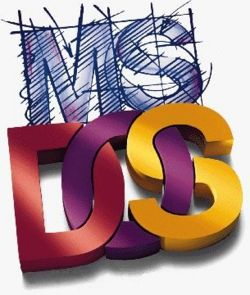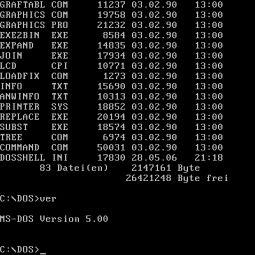Difference between revisions of "Configuration:DOS"
(Created page with "== Platform Information == === Media Devices === * Original Media == Available Emulators == Below is a list of available emulators for this platform. * [[Emulator:DOSBox|DOSBo...") |
|||
| (10 intermediate revisions by 2 users not shown) | |||
| Line 1: | Line 1: | ||
| + | {{Infobox System|Logo=Logo-msdos.png|Image=Software-msdos-500.jpg|Year=1991|Manufacturer=Microsoft|Type=Personal Computer|CPU=N/A|GPU=N/A|Sound CPU=N/A|Sound Chip=N/A|Memory=N/A|Controllers=Keyboard<br>Joystick}} | ||
| + | |||
== Platform Information == | == Platform Information == | ||
| + | ''from Wikipedia'' | ||
| + | |||
| + | MS-DOS (/ˌɛmɛsˈdɒs/ EM-es-DOSS; acronym for Microsoft Disk Operating System) is a discontinued operating system for x86-based personal computers mostly developed by Microsoft. Collectively, MS-DOS, its rebranding as IBM PC DOS, and some operating systems attempting to be compatible with MS-DOS, are sometimes referred to as "DOS" (which is also the generic acronym for disk operating system). MS-DOS was the main operating system for IBM PC compatible personal computers during the 1980s and the early 1990s, when it was gradually superseded by operating systems offering a graphical user interface (GUI), in various generations of the graphical Microsoft Windows operating system. | ||
| + | |||
| + | MS-DOS resulted from a request in 1981 by IBM for an operating system to use in its IBM PC range of personal computers. Microsoft quickly bought the rights to 86-DOS from Seattle Computer Products, and began work on modifying it to meet IBM's specification. IBM licensed and released it in August 1981 as PC DOS 1.0 for use in their PCs. Although MS-DOS and PC DOS were initially developed in parallel by Microsoft and IBM, the two products diverged after twelve years, in 1993, with recognizable differences in compatibility, syntax, and capabilities. | ||
| + | |||
| + | During its lifetime, several competing products were released for the x86 platform, and MS-DOS went through eight versions, until development ceased in 2000.Initially MS-DOS was targeted at Intel 8086 processors running on computer hardware using floppy disks to store and access not only the operating system, but application software and user data as well. Progressive version releases delivered support for other mass storage media in ever greater sizes and formats, along with added feature support for newer processors and rapidly evolving computer architectures. Ultimately it was the key product in Microsoft's growth from a programming languages company to a diverse software development firm, providing the company with essential revenue and marketing resources. It was also the underlying basic operating system on which early versions of Windows ran as a GUI. It is a flexible operating system, and consumes negligible installation space. | ||
=== Media Devices === | === Media Devices === | ||
| Line 7: | Line 16: | ||
Below is a list of available emulators for this platform. | Below is a list of available emulators for this platform. | ||
| + | * [[Emulator:MAME-ct486|MAME - ct486]] | ||
* [[Emulator:DOSBox|DOSBox]] | * [[Emulator:DOSBox|DOSBox]] | ||
| − | * [[Emulator: | + | * [[Emulator:DOSEmu|DOSEmu]] |
| + | * [[Emulator:bochs|bochs]] | ||
| + | * [[Emulator:pce_pcemulator|PCE]] | ||
| + | |||
| + | |||
| + | == Virtualization Platforms == | ||
| + | * [[Virtualization:QEMU|QEMU]] | ||
| + | * [[Virtualization:VirtualBox|VirtualBox]] | ||
| + | |||
| + | == External Links == | ||
| + | * [https://en.wikipedia.org/wiki/MS-DOS Wikipedia] | ||
| + | |||
| + | |||
| + | [[Category:Platform]] | ||
Latest revision as of 05:23, 11 February 2020
| DOS | ||
|---|---|---|

| ||

| ||
| Manufacturer | Microsoft | |
| Type | Personal Computer | |
| CPU | N/A | |
| GPU | N/A | |
| Sound CPU | N/A | |
| Sound Chip | N/A | |
| Memory | N/A | |
| Controllers | Keyboard Joystick | |
| Year | 1991 | |
Platform Information
from Wikipedia
MS-DOS (/ˌɛmɛsˈdɒs/ EM-es-DOSS; acronym for Microsoft Disk Operating System) is a discontinued operating system for x86-based personal computers mostly developed by Microsoft. Collectively, MS-DOS, its rebranding as IBM PC DOS, and some operating systems attempting to be compatible with MS-DOS, are sometimes referred to as "DOS" (which is also the generic acronym for disk operating system). MS-DOS was the main operating system for IBM PC compatible personal computers during the 1980s and the early 1990s, when it was gradually superseded by operating systems offering a graphical user interface (GUI), in various generations of the graphical Microsoft Windows operating system.
MS-DOS resulted from a request in 1981 by IBM for an operating system to use in its IBM PC range of personal computers. Microsoft quickly bought the rights to 86-DOS from Seattle Computer Products, and began work on modifying it to meet IBM's specification. IBM licensed and released it in August 1981 as PC DOS 1.0 for use in their PCs. Although MS-DOS and PC DOS were initially developed in parallel by Microsoft and IBM, the two products diverged after twelve years, in 1993, with recognizable differences in compatibility, syntax, and capabilities.
During its lifetime, several competing products were released for the x86 platform, and MS-DOS went through eight versions, until development ceased in 2000.Initially MS-DOS was targeted at Intel 8086 processors running on computer hardware using floppy disks to store and access not only the operating system, but application software and user data as well. Progressive version releases delivered support for other mass storage media in ever greater sizes and formats, along with added feature support for newer processors and rapidly evolving computer architectures. Ultimately it was the key product in Microsoft's growth from a programming languages company to a diverse software development firm, providing the company with essential revenue and marketing resources. It was also the underlying basic operating system on which early versions of Windows ran as a GUI. It is a flexible operating system, and consumes negligible installation space.
Media Devices
- Original Media
Available Emulators
Below is a list of available emulators for this platform.